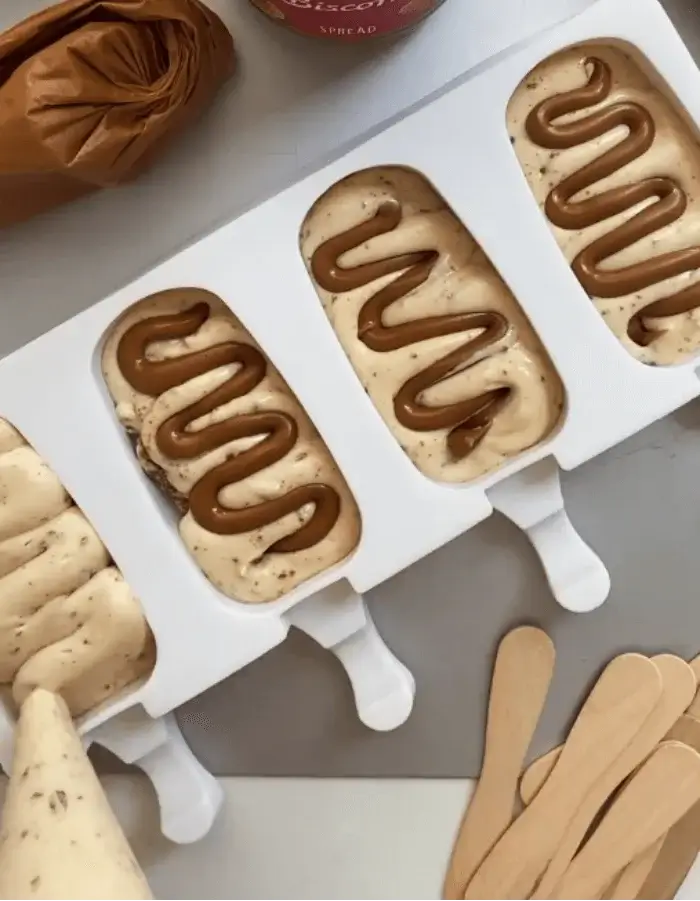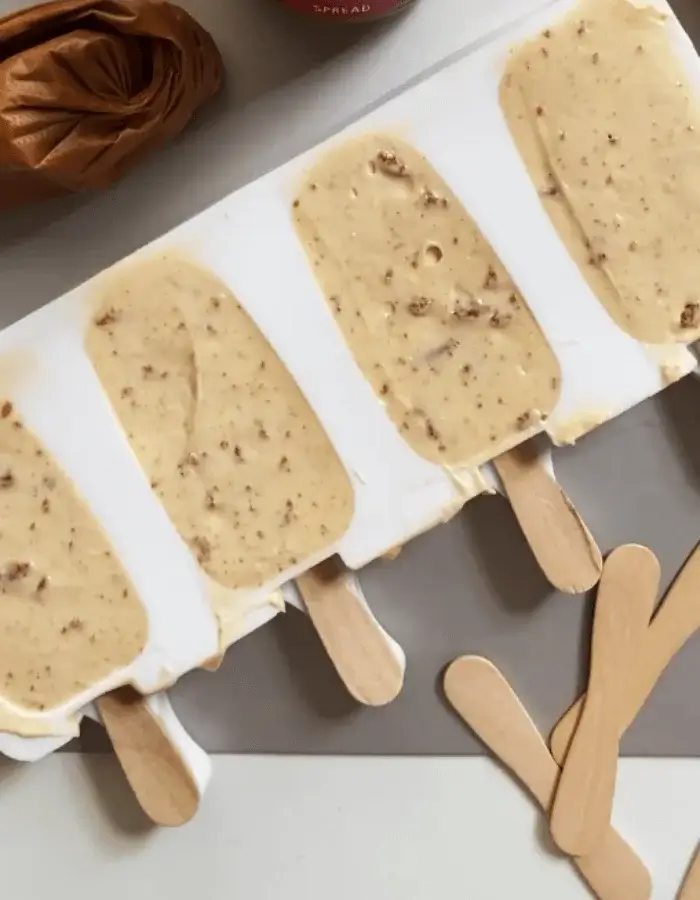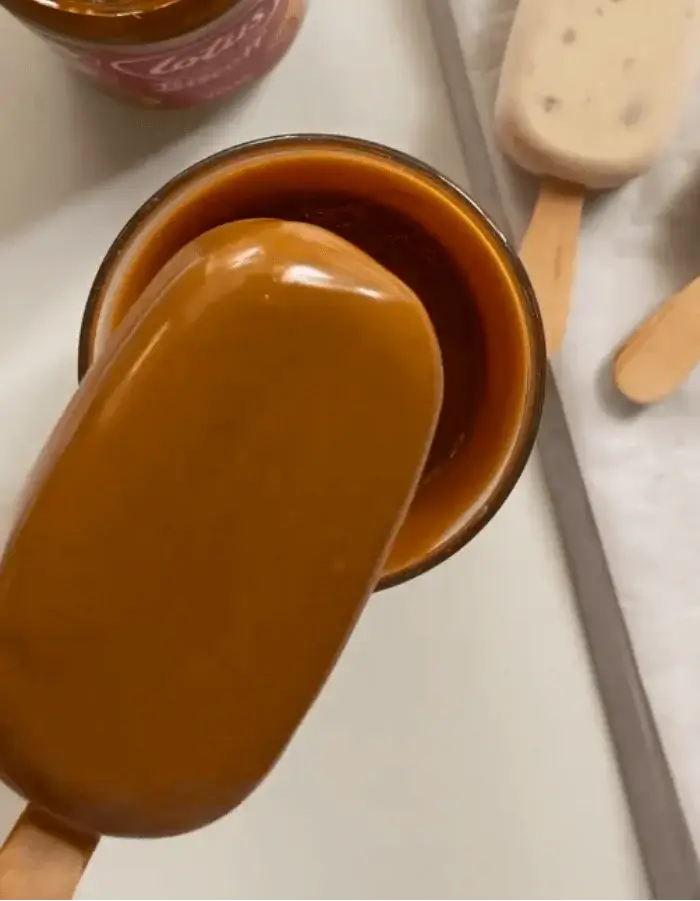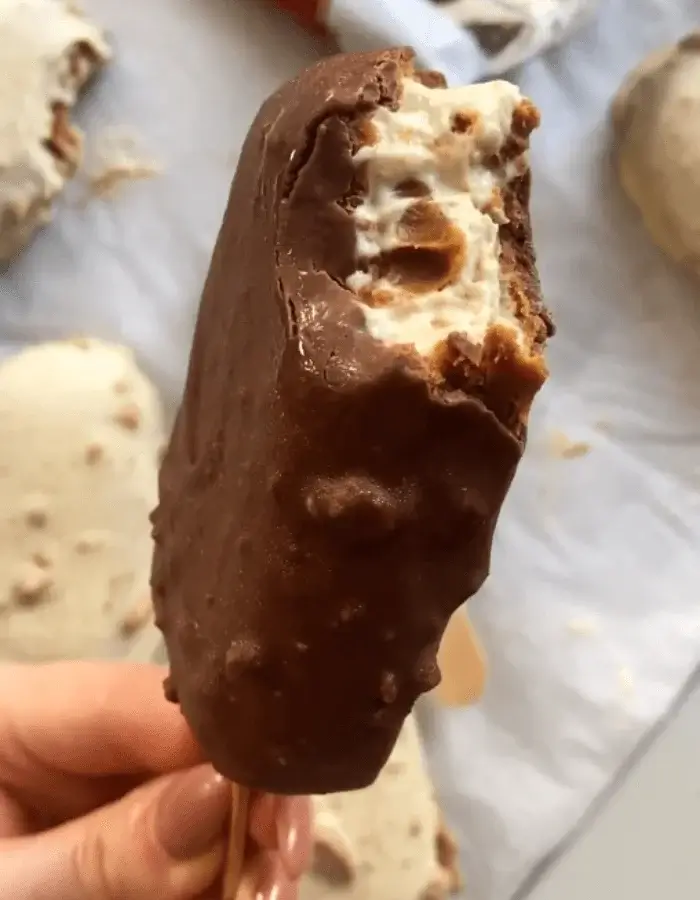Biscoff Ice Cream Bars
We may earn a commission from recommended products, at no extra cost to you. See Disclosure.
- Piping bags
- Silicone popsicle molds
- Baking sheets
- Tall dipping glasses
- Wooden popsicle sticks
INGREDIENTS
- 2 cups/500 milliliters heavy cream
- 1 1/4 cups/400 grams sweetened condensed milk
- 7 ounces/200 grams mascarpone cheese
- 10 Lotus Biscoff cookies, finely crushed
- 2 tablespoons Lotus Biscoff spread
Filling:
- 3 tablespoons Biscoff spread, transferred to a piping bag
First coating:
- 1 1/4 cups/300 grams Lotus Biscoff spread, melted
Second coating:
- 1 3/4 cups/300 grams white or milk chocolate, chopped
- 3 tablespoons oil
- 5 Lotus Biscoff cookies, crushed
INSTRUCTIONS
- In the bowl of a stand mixer fitted with the whisk attachment, combine the heavy cream, mascarpone, and Biscoff spread. Whip on medium speed until soft, fluffy peaks form. Add the sweetened condensed milk and whip briefly, just until the mixture is fully combined and smooth.
- Gently fold in the crushed cookies using a rubber spatula, being careful not to deflate the mixture. Transfer the ice cream base to a piping bag.
- Place silicone popsicle molds on a flat baking sheet for stability. Pipe the ice cream mixture halfway up each mold. Pipe a small amount of Biscoff spread into the center of each, then fill to the top with more ice cream mixture. Smooth the surface with a small offset spatula. Insert wooden popsicle sticks and freeze for at least 8 hours, or overnight, until completely firm.
- Once frozen, carefully unmold the bars and place them on a parchment-lined baking sheet. Return to the freezer while preparing the first coating.
- Melt the Biscoff spread in a wide, microwave-safe cup or bowl in 30-second intervals, stirring between each, until completely smooth and pourable. Working quickly, dip each bar into the melted spread, letting excess drip off. Return each coated bar to the baking sheet and freeze for 2 hours, or until fully set.
- For the second coating, combine the chopped chocolate and canola oil in a microwave-safe bowl. Microwave in 30-second bursts, stirring well between each, until the chocolate is fully melted and smooth. Stir in the crushed cookies. Transfer the mixture to a tall, narrow glass or cup.
- Remove the bars from the freezer and dip each one into the chocolate mixture. Let the excess drip off, then place the bars back onto the parchment-lined baking sheet. Freeze until the coating is fully set and the bars are firm. Serve directly from the freezer.

FAQ
How can I make Biscoff ice cream bars dairy-free?
Substitute the heavy cream with full-fat coconut cream and use a plant-based mascarpone or a thick cashew cream. Replace the sweetened condensed milk with a dairy-free version, which is now available in oat or coconut-based options. Ensure that the chocolate used for the coating is also dairy-free, and check that the Lotus cookies and Biscoff spread don’t contain hidden milk ingredients. The texture may vary slightly but the flavor will still be rich and satisfying.


What can I use instead of popsicle molds?
If you don’t have popsicle molds, you can make Biscoff ice cream bars using small paper cups or silicone muffin cups as molds. Fill them with the ice cream mixture as directed, insert a wooden stick into the center, and freeze until solid. Once frozen, peel off the paper or unmold the silicone. These substitutes won’t give the same precise shape but work perfectly in terms of structure and portion size. Just make sure your mold is deep enough to hold the filling layer.
Do I need to use mascarpone cheese?
Mascarpone cheese gives Biscoff ice cream bars a smooth, creamy texture and subtle tang, but if unavailable, you can substitute with full-fat cream cheese or even whipped ricotta. Be sure to use a soft, spreadable variety and blend it well with the cream to avoid lumps. Keep in mind that substitutions may slightly affect the flavor profile, especially if the cheese is more tangy or grainy. The overall structure of the bars will still hold up well.
How long do these Biscoff ice cream bars keep in the freezer?
The bars will keep well in the freezer for up to 2 months if stored properly. To prevent freezer burn or unwanted flavors, wrap each bar individually in parchment paper or plastic wrap, then store them in an airtight container or zip-top bag. If you’ve already dipped them in the coatings, make sure they are fully set and frozen before wrapping. For best texture, let them sit at room temperature for 1 to 2 minutes before serving.

Can I make these Biscoff ice cream bars without a stand mixer?
You can make Biscoff ice cream bars without a stand mixer. Use a handheld electric mixer to whip the cream, mascarpone, and Biscoff spread together until soft peaks form. If you don’t have an electric mixer at all, whisking by hand is possible but will take longer and require chilled equipment and strong arm stamina. Be careful not to over-whip the cream to avoid a grainy texture. Fold in the cookies gently once the base is whipped.
What’s the best way to crush the Lotus cookies?
Place them in a zip-top bag and roll over them with a rolling pin until they’re evenly crumbled. For a finer texture, use a food processor and pulse briefly until the cookies resemble coarse sand. You want a mix of textures—some powdery bits for blending into the ice cream, and some larger crumbs for the coating. Avoid over-processing into a paste, which can become too sticky when mixed with chocolate.
How do I prevent the bars from melting while dipping?
Work in small batches—no more than four bars at a time—and keep the rest in the freezer. Make sure your coatings are fully melted and warm but not hot, so the dip happens quickly. Use a tall, narrow glass for smoother coating, and let any excess drip off quickly. After each dip, place the bar immediately on a parchment-lined tray and return it to the freezer.

